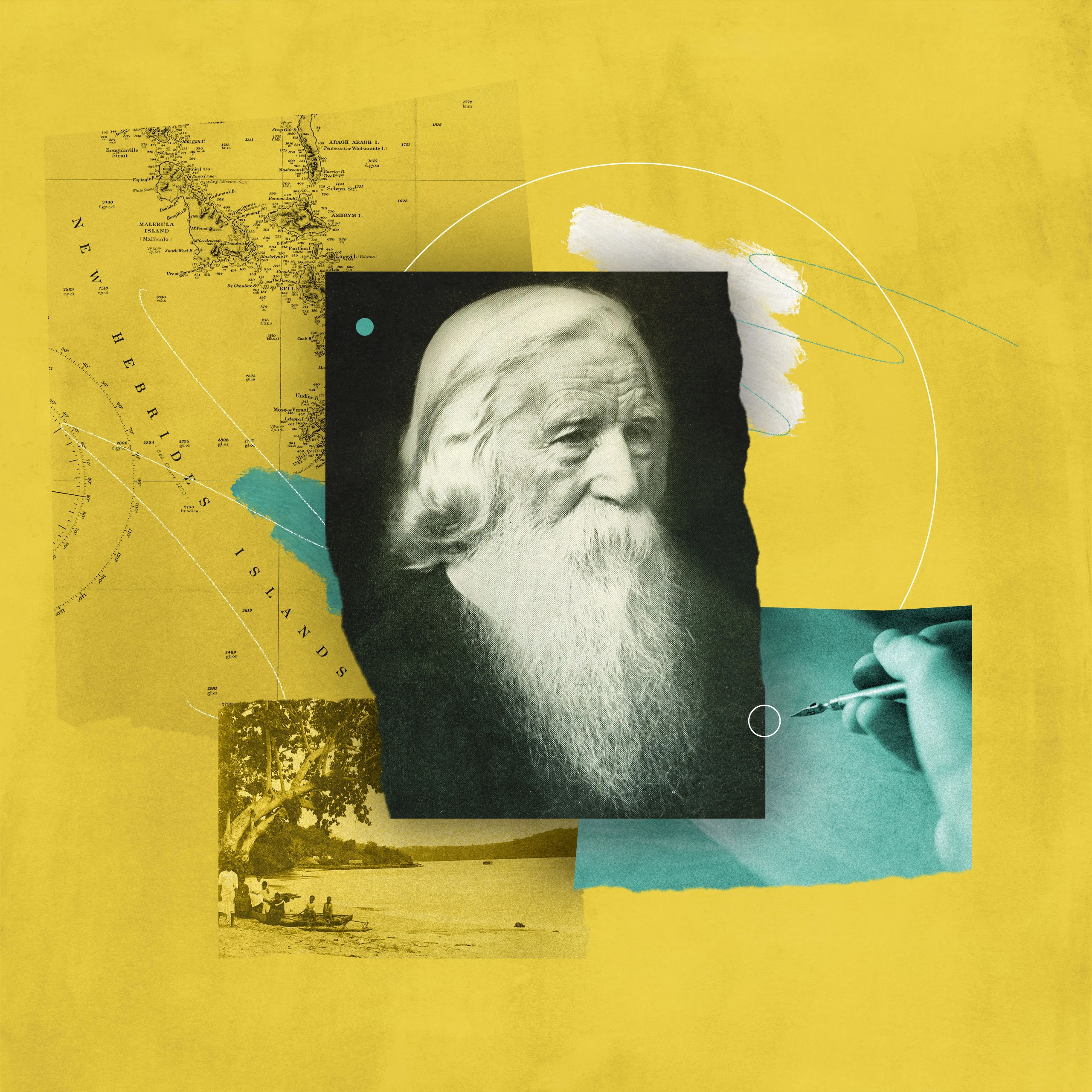Who Was John G. Paton?

Vanuatu is a nation of more than eighty islands, previously called the New Hebrides, just east of Papua New Guinea. On November 19, 1839, the first missionaries to this little-known island nation, Rev. John Williams and James Harris, landed and were grotesquely slain the next day.1 This act was later understood to be revenge for atrocities committed by foreign traders days before.2 A cycle of violence subsequently gripped these islands, but a dark spiritual oppression gripped them as well. This conviction of spiritual oppression led Scottish missionary John G. Paton to the New Hebrides and held him there through many exciting providences as he sought to minister the light of the gospel.
Sincerely Reformed
John Gibson Paton was born May 24, 1824, in Dumfriesshire, Scotland. His parents, James Paton and Janet Rogerson, were from humble means but were rich in their sincere faith. John Paton poetically remembers their deep conviction in his autobiography, where he describes his father’s consistent prayers and intentional study of church history. Recognizing the impact of his father’s affectionate observation and instruction of his children, John declared, “God help the homes where these things are done by force and not by love!”3 Two of James Paton’s sons became devoted pastors, and four more generations of missionaries would follow.
Among his many skills, John Paton was a gifted storyteller: reflective, generously emotive, rich in theology, and full of missional conviction. Paton resolved to become a missionary shortly after his conversion at age twelve and devoted himself to the study of Latin and Greek. His missionary resolve was more than once challenged, beginning with an offer for the gifted student to pursue scholarship. He regretfully declined this opportunity, not wanting to make a long-term commitment that would “frustrate the purpose of [his] life.”4 Paton remarked, “Almost overpowering was the impulse to answer aloud, ‘Here am I, send me.’ ”5
Sincerely Called
Though he received an internal call at age twelve, it would be twenty-three years before he made it to the New Hebrides. In response to the martyrdom of Williams and Harris, Paton penned: “Thus were the New Hebrides baptized in the blood of martyrs . . . [They] knew not that they had slain their best friends; but tears and prayers ascended for them from all Christian souls, wherever the story of martyrdom on Erromanga was read or heard.”6 The next missionary group to the New Hebrides narrowly escaped after just seven months. Finally, Canadian missionary Rev. Dr. John Geddie successfully landed on the most southern island in 1848. Paton would join him eleven years later. The dangers did not cease. Rather, many more native converts and foreign missionaries, including Paton’s co-laborers Rev. and Mrs. G.N. Gordon, would also go on to wear “the crown of martyrdom.”7
While violence and cannibalism quickly became the reputation of this region, Paton’s missionary purpose remained unmoved in the face of many efforts to dissuade him.
While violence and cannibalism quickly became the reputation of this region, Paton’s missionary purpose remained unmoved in the face of many efforts to dissuade him. Against the arguments of his presbytery who tried to convince him not to go, the faithful pastor solemnly said, “It will make no difference to me whether I am eaten by Cannibals or by worms; and in the Great Day my Resurrection body will rise as fair as yours in the likeness of our risen Redeemer.”8 When Paton finally received his external call at age thirty-five and landed in the region in 1859, he was quickly “stunned by the dreadful loss” of his first wife, Mary Ann Robson, to fever.9 Their newborn son, Peter, followed three weeks later. His ministry was undergirded by this reigning thought: “This is strength; — this is peace: — to feel, in entering on every day, that all its duties and trial have been committed to the Lord Jesus, — that, come what may, He will use us for His glory and our own real good!”10
A Matter of Worship
Paton stayed on the island of Tanna, where the focus of his ministry was Sabbath day worship. As the gathering grew to about forty natives, Paton wrote that the Tannese “resolved that we should be killed, because, as they said, they hated Jehovah and the Worship; for it made them afraid to do as they had always done.”11 Locals worshiped and were knowingly enslaved to “a spirit of evil,” trapped in a cycle of propitiation to an invisible world channeled through idols of stone.12 The culture valued deception and taboos and practiced arson, witchcraft, and a marked degradation of women. Tribal wars were followed by revenge and ritual human sacrifice and cannibalism. The first martyr of Paton’s ministry was a native who with his dying breath prayed: “For the sake of Jesus! . . . Forgive them, for they know not what they are doing. . . Take not away Thy Worship from this dark Island!”13
Paton’s goal was to point image-bearers to our Creator-God.14 He did not leave known abuses of his “fellow-countrymen” unchecked,15 nor did he ignore academic objections to engaging a primitive tribe, saying: “All the scepticism of Europe would hide its head in foolish shame; and all its doubts would dissolve under one glance of the new light that Jesus, and Jesus alone, pours from the converted cannibal’s eye.”16 God preserved Paton and his early Tannese translations of Scripture, which were nearly lost by shipwreck and unsuccessful theft. In 1862, Paton was forced to flee Tanna due to religious persecution. He spent the next four years traveling to Australia and then Scotland, recruiting new missionaries and partners.
In 1864, Paton met and married Margaret (Maggie) Whitecross, daughter of the notable Rev. John Whitecross. Maggie was a talented artist, and she translated hymns and later wrote Letters and Sketches from the New Hebrides.17 The Patons returned to the New Hebrides—to the island of Aniwa—in 1866. Upon sighting the ship, the natives cried:
We slew or drove them all away! We plundered their houses and robbed them. Had we been so treated, nothing would have made us return. But they come back with a beautiful new ship, and with more and more Missionaries. And is it to trade and to get money, like the other white men? No! No! But to tell us of their Jehovah God and of His Son Jesus. If their God makes them do all that, we may well worship Him too.18
In God’s providence, God used Paton and his efforts. Much of the island was converted.19 The Patons had ten children, six of whom survived to adulthood. Efforts to recruit missionaries continued throughout Paton’s life, and he campaigned in Australia, Scotland, Ireland, England, the United States, and Canada. He continued to translate and print the Bible along with his son, Fred, into his eighties, publishing the New Testament, catechism, and a hymnbook in Aniwan. Four generations of Patons went on to serve the New Hebrides church, which remains to this day.20 The impact of John G. Paton’s final ministry was
fully sustained by the Native Teachers, the Elders, and the occasional visit, once or twice a year, of an ordained Missionary from one of the other islands. Aniwa, like Aneitym, is a Christian land. Jesus has taken possession, never again to quit those shores.21
-
George Patterson, Missionary Life Among the Cannibals: Being the Life of the Rev. John Geddie, D.D., First Missionary to the New Hebrides: with a with a History of the Nova Scotia Presbyterian Mission on that Group (Toronto: James Campbell and Son, James Bain & Son, and Hart & Co., 1882), 134. ↩
-
Briony Leyland, “Island holds reconciliation over cannibalism.” BBC News: Erromango, December 7, 2009. http://news.bbc.co.uk/2/hi/uk_news/england/hampshire/8398126.stm ↩
-
John Paton, John G. Paton: Missionary to the New Hebrides: An Autobiography, ed. Rev. James Paton (Geanies House: Christian Focus Publications, Ltd., 2009), 17. ↩
-
Ibid., 21. ↩
-
Ibid., 42. ↩
-
Ibid, 56. ↩
-
Ibid., 125. ↩
-
Ibid., 44. ↩
-
Ibid., 60. ↩
-
Ibid., 101. ↩
-
Ibid., 86. See also 87, 129, 232. ↩
-
Ibid., 55, 252. ↩
-
Ibid., 91. ↩
-
Ibid., 328. ↩
-
Ibid., 83. See also 324. ↩
-
Ibid., 82. See also 328. ↩
-
Ibid., 280. ↩
-
Ibid., 232. ↩
-
Ibid, 244. ↩
-
J. Graham Miller, Live: A History of Church Planting in Vanuatu, vol. 3 (Port Vila, Vanuatu: Presbyterian Church of Vanuatu, 1985), 273. ↩
-
Paton, 354. ↩


